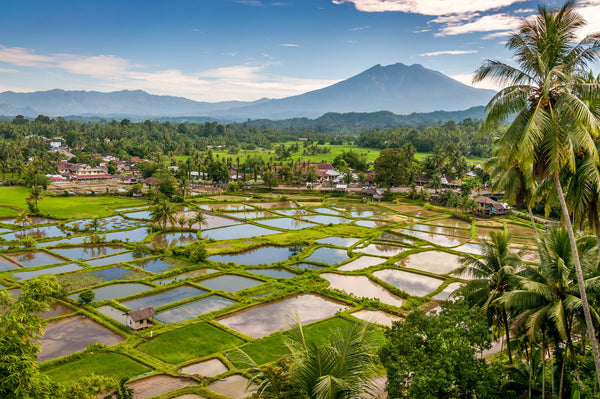February 8, 2024
Our tour of coffee producing countries takes us to Indonesia this month. Indonesia is the world’s largest archipelago, made up of over 17,500 islands! It is located in Southeast Asia between the Pacific and Indian oceans. As an equatorial country, Indonesia has a fairly consistent climate with only two seasons, wet and dry. The tropical climate and plentiful mountain ranges make it hospitable to the cultivation of a multitude of coffee varieties, but the main focus is on Arabica and Robusta.


Coffee was introduced in Indonesia in 1696 by Dutch colonial governors and in 1717 the first coffee export was sent to Amsterdam where it was sold as a luxury good. Indonesia was the first country outside of Ethiopia and Arabia where coffee was widely cultivated. This cultivation was very profitable for the Dutch companies who were present in Indonesia, but profits were not shared with the Indonesian coffee farmers who were producing the cash crop. The Dutch spread this exploitative model of coffee production across many islands in the archipelago, focusing on arabica production and then introducing robusta varietals. In the 1950’s, once Indonesia won independence, the coffee cultivation system was nationalized and today, 90% of coffee is produced by small-holder farmers with 1 to 2 hectares of land. Most of Indonesia’s coffee cultivation is concentrated in 7 different islands with Sumatra being the largest producing region in the archipelago.

Although there are several different processing methods used, Indonesian coffee is most often associated with the wet-hulling process in which the coffee cherry is removed from the seed and the seed still coated in the sticky mucilage is stored before being dried. This process creates the quintessential Indonesian coffee attributes of a lower acidity and full body.
Wet hulling may be the most common coffee processing method in Indonesia, however, kopi luwak is the most unique. Kopi luwak processing occurs when the Asian palm civet, akin to a mongoose, eats coffee cherries and digests them, leaving the seeds behind. The seeds are washed and sold, prized for their sweet and mild taste, sometimes selling for as much as $600 per kilogram.
As in most coffee producing countries, most Indonesian coffee is exported, however, there is a rich coffee culture in Indonesia. Those in large cities and in rural villages have distinct ways that they enjoy local Indonesian coffee. In cities, street vendors serve a variety of beverages to passersby such as kopi tubruk, strong coffee brewed in a cup with sugar. In some Western Sumatran villages, people enjoy coffee beverages brewed from steeping coffee leaves in water.

At Westrock Coffee Company, we love what Indonesian coffees can bring to the table to round out our blends as they are most often known for their earthiness and heavy body. They also often will carry notes of spice, cedar, leather, and tobacco due, in part, especially in Sumatra, to their wet-hulled processing. If you can’t make it to Indonesia to try kopi tubruk for yourself, enjoy a Westrock Coffee blend to experience what Indonesian coffee has to offer.





